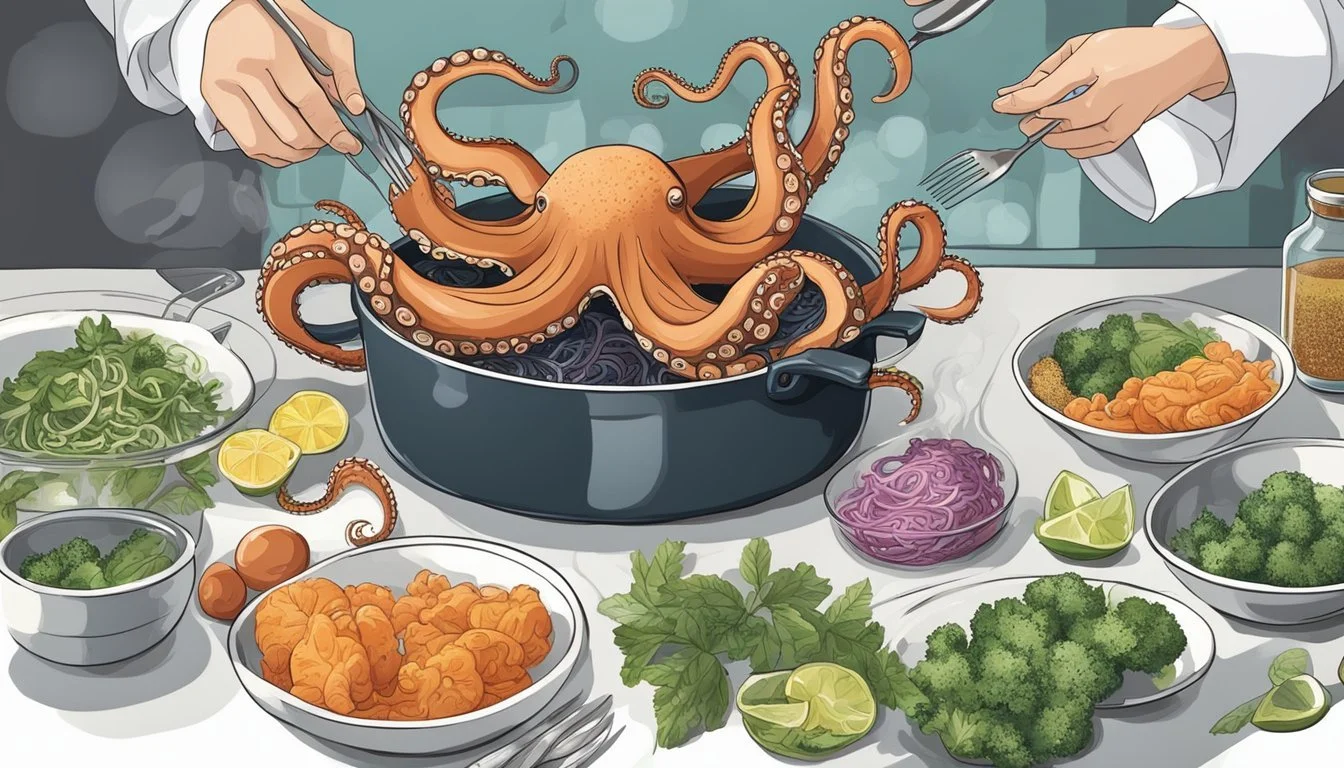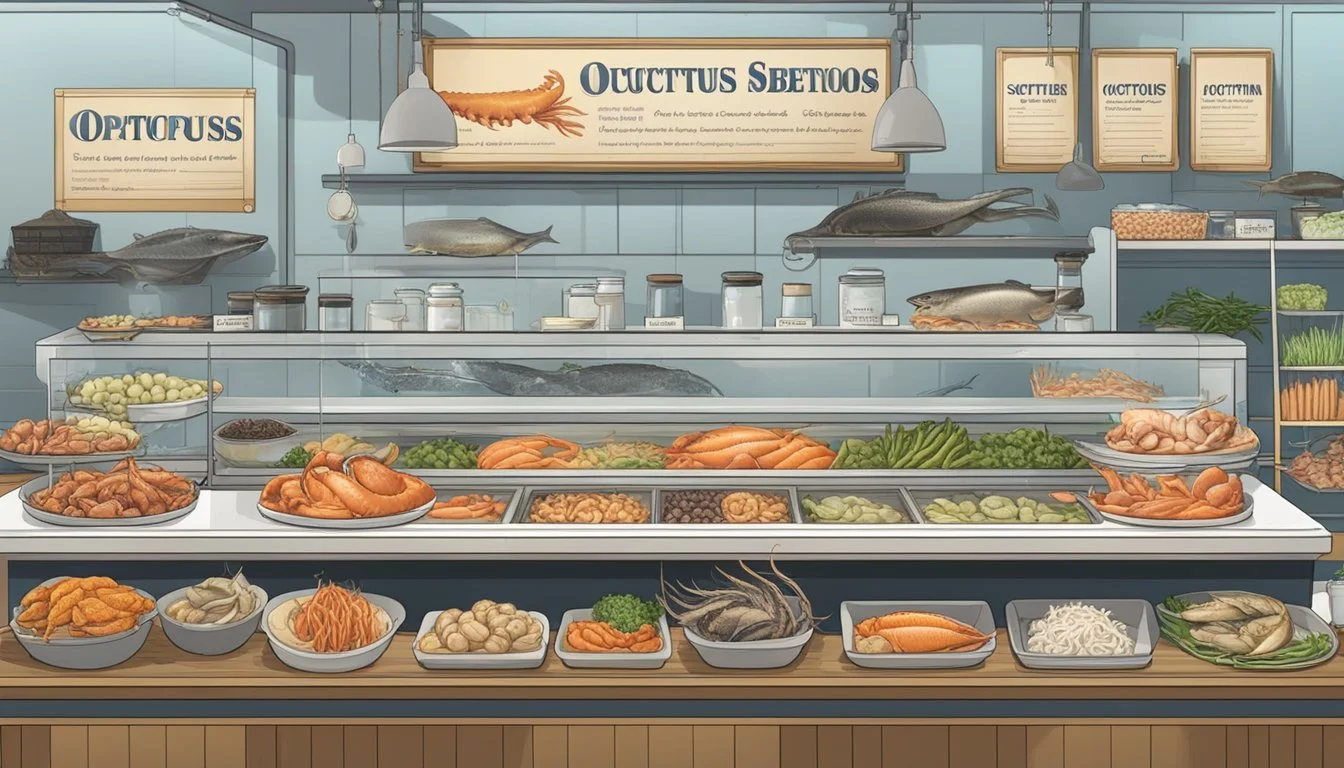Octopus Substitutes
Sustainable Alternatives for Seafood Lovers
Finding suitable octopus substitutes can be a game-changer for those looking to enjoy similar textures and flavors without using actual octopus. One excellent alternative is squid, which shares a chewy and slightly rubbery texture similar to octopus, along with a mild and slightly sweet taste. This substitute is versatile and fits well into various seafood dishes.
For those on a plant-based diet, vegan options such as tofu and konjac offer great alternatives. Tofu, with its adaptable texture, can mimic the firmness of octopus when cooked, while konjac provides a low-calorie option that absorbs flavors well. Incorporating these into dishes like vegan takoyaki can yield satisfying results for vegetarians and vegans alike.
Shrimp is another seafood substitute that offers an elastic and plump texture, making it another excellent option for replicating octopus in recipes. By seasoning shrimp properly, it can be used in dishes catering to a variety of tastes and dietary preferences, providing both a satisfying texture and a unique flavor profile.
Understanding Octopus in Cuisine
Octopus plays a significant role in various culinary traditions, especially in Japanese and Mediterranean cuisines. It's prized for its unique texture and flavor, offering both nutritional benefits and culinary versatility.
Nutritional Profile and Health Benefits
Octopus is rich in protein and essential nutrients. It provides vitamins B6, B12, and niacin, crucial for metabolism and energy production. The mineral content, including zinc, iron, and selenium, supports different bodily functions such as the immune system.
Low in fat and calories, octopus is an excellent seafood option for those watching their weight. Additionally, the omega-3 fatty acids present in octopus promote heart health. Cooking methods like boiling or grilling preserve these nutrients, making it a healthful addition to meals.
Culinary Uses of Octopus
In Japanese cuisine, octopus is a staple in dishes such as sushi, sashimi, and takoyaki. Takoyaki, street food, consists of octopus pieces in ball-shaped batter, cooked in a special pan. Boiled octopus is also common, enjoyed for its tender texture.
Mediterranean recipes often feature grilled or marinated octopus. For instance, Greek cuisine includes grilled octopus with lemon sauce, highlighting its natural flavors. The culinary use of octopus extends to stews and salads, where its unique texture enhances the dish's complexity.
By understanding octopus in the context of nutrition and culinary applications, one can better appreciate its role in global cuisines.
Popular Octopus Dishes and Preparation
Octopus is a versatile seafood ingredient enjoyed globally in a variety of traditional dishes. Key methods of preparation include boiling, grilling, and frying, often accompanied by distinctive seasonings and sauces that enhance its natural flavor.
Takoyaki and Its Origins
Takoyaki, originating from Osaka, Japan, is a popular street food featuring bite-sized octopus-filled balls. Ingredients: octopus pieces, takoyaki batter (flour, water, and eggs), and green onions. The batter is poured into special takoyaki molds, half-cooked, and then filled with octopus pieces and green onions before being turned to finish cooking into golden spheres.
Takoyaki Sauce – a vital component – is drizzled over the finished balls. It typically consists of Worcestershire sauce, ketchup, soy sauce, and sugar. Takoyaki is often enjoyed during casual gatherings called Takoyaki parties, where friends and family cook and relish these delectable treats together.
Preparing Octopus
Preparing octopus involves a few essential steps to ensure it is tender and flavorful. Start by thoroughly cleaning the octopus, removing the beak and internal organs.
Next, tenderizing is crucial; chefs commonly use methods such as massaging the flesh or gently boiling it with a wine cork in the pot, which some believe absorbs impurities, although this is based more on tradition than scientific evidence. Seasoning options like salt, paprika, and olive oil enhance the natural taste when grilling or frying.
Global Octopus Recipes
Octopus recipes vary widely across cultures. In Galicia, Spain, Grilled Octopus (Pulpo a la Gallega) features boiled octopus served with olive oil, paprika, and sea salt. This dish highlights the octopus's natural flavors through simple seasoning and is often presented on wooden platters.
In Peru, Pulpo al Olivo combines octopus with a rich olive sauce made from botija olives, served as a main course or appetizer. In China, spicy stir-fried octopus is popular, often cooked with garlic, chili peppers, and soy sauce for a flavorful heat that complements the tender meat. These diverse recipes showcase octopus's adaptability and the rich culinary traditions it inspires around the world.
Alternatives to Octopus
Finding an effective substitute for octopus can be crucial for various dietary needs, preferences, and allergies. Suitable alternatives span vegetarian, vegan, seafood-based, and even poultry options.
Vegetarian and Vegan Substitutes
King oyster mushrooms are among the best plant-based alternatives. Their chewy texture mimics octopus well, making them ideal for dishes like takoyaki.
Shiitake mushrooms are another viable option due to their robust flavor and firm texture.
Konnyaku, also known as konjac or konjac yam, provides a gelatinous texture that can closely resemble octopus.
Jackfruit can be used for its fibrous consistency, particularly in stews and soups.
Tofu serves as a versatile substitute, absorbing flavors while providing a satisfying bite.
Seafood-Based Options
Squid is a popular substitute, closely mimicking the texture of octopus.
Cuttlefish offers a similar consistency and can be easily integrated into recipes requiring octopus.
Scallops provide a delicious seafood alternative, especially in dishes where a delicate flavor is desired.
Shrimp and tuna can also be used as substitutes, with shrimp offering a tender texture and tuna providing a heavier, meatier bite.
These options can be marinated and cooked similarly to octopus to yield comparable culinary results.
Poultry and Other Meat Substitutes
Chicken can serve as a practical substitute in many recipes. Its neutral taste allows it to absorb a variety of flavors, making it a flexible option.
For those looking for different meat options, turkey offers a similar versatility. Both can be cut into smaller pieces to simulate the size and texture of octopus chunks.
These alternatives can be particularly useful in dishes where the texture is more critical than the flavor profile of the octopus.
Cooking with Octopus Substitutes
Cooking with octopus substitutes introduces unique flavors and textures to various dishes while catering to different dietary preferences. Mastering seasoning and adjusting textures ensures the best results.
Adjusting Seasoning and Texture
When using octopus substitutes, seasoning plays a crucial role. For seafood-like flavors, ingredients such as soy sauce, miso, and fish sauce are effective. Balancing salt levels and incorporating flavors like ginger and garlic also enhance the taste.
Texture is equally important. Substitutes like squid, cuttlefish, or vegetarian options such as konjac and mushrooms often require marinating. This helps in achieving a tender yet firm bite. For a vegan substitute, tofu and tempeh provide versatile options. Ensuring the correct cooking time to prevent overcooking is vital, particularly for seafood alternatives.
Incorporation in Traditional Dishes
In traditional dishes like takoyaki or tempura, octopus substitutes seamlessly integrate with some adjustments. Takoyaki benefits from ingredients such as shiitake mushrooms or vegan konjac. The substitute should be diced into small, uniform pieces to mimic octopus. Adding seasoned sauce on top completes the dish.
For tempura, options like shrimp, squid, or vegetables such as eggplant and zucchini serve well. The batter should be light and crispy. Fry the chosen substitute until golden brown for the best results. Each piece should be drained on paper towels to remove excess oil, ensuring a crunchy texture.
Supplementary Ingredients in Octopus Dishes
When preparing octopus dishes, the inclusion of certain supplementary ingredients can significantly enhance flavors, add texture, and complement the dish's overall profile. These elements range from various seasonings and vegetables to specialized sauces and toppings that can elevate the culinary experience.
Enhancing Flavors and Aromas
Many octopus dishes benefit from seasoning such as salt and pepper, which bring out the natural flavors of the seafood. Green onions and scallions are commonly added for a fresh and slightly pungent aroma.
For a bit more complexity, incorporating dashi – a Japanese soup stock – can deepen the flavors. Nori seaweed and katsuobushi (bonito flakes) add umami, enriching the dish with a savory profile. In some recipes, natto or kimchi can provide a unique, fermented twist that combines well with the seafood.
Texture Elements in Dishes
Eggs play a crucial role in many octopus dishes by adding richness and binding ingredients together. For example, in Japanese cuisine, eggs are combined in batter-based dishes like takoyaki. Tenkasu (crunchy tempura bits) mixed into the batter offers a delightful contrast with crunchy textures.
Substitutes such as konjac or tofu can be used to either mimic the meaty texture of octopus or provide a slightly different, yet complementary, texture. Cheese, when melted, also adds a creamy texture that pairs well with the firmness of octopus. Additionally, using all-purpose flour and baking powder can create a light, airy texture in various preparations.
Sauces and Toppings
The choice of sauces and toppings can dramatically enhance an octopus dish. Worcestershire sauce and mayonnaise are often used in takoyaki to add tang and creaminess. For authenticity, takoyaki sauce – a sweet and savory blend – is drizzled on top of dishes.
Rice vinegar provides a slight tartness that balances the richness of the octopus. Bonito flakes scattered on top not only add flavor but also a dynamic visual element as they move with the heat. Kimchi can serve as a spicy counterpart, offering both heat and complexity. Eggs, especially when soft-boiled, add a silky richness that complements the chewiness of octopus.
By thoughtfully incorporating these supplementary ingredients, one can enhance an octopus dish's complexity and enjoyment.
Cultural Significance
Octopus dishes hold a notable place in various cultures, from traditional fare in Spain's Galicia to modern interpretations in Japan. Vegetarianism has brought about diverse seafood alternatives, addressing ethical and dietary preferences.
Octopus in Global Cuisine
Octopus has been an important culinary element in many regions. In Galicia, Spain, pulpo a la gallega is a beloved dish, featuring boiled octopus seasoned with olive oil, paprika, and salt. This traditional meal is often enjoyed during local festivals, highlighting its cultural importance.
In Japan, takoyaki represents another iconic octopus dish. These savory balls, cooked in special pans, combine octopus pieces with batter and are drizzled with takoyaki sauce. They are popular street food, showcasing Japan's innovative approach to using octopus in diverse recipes.
Vegetarianism and Seafood Alternatives
As vegetarianism rises, octopus substitutes gain attention. Vegan and vegetarian alternatives like tofu and konjac are used to replicate the texture and flavor of octopus dishes. For vegan takoyaki, tofu or konjac can replace octopus, mixed into the batter, and cooked in traditional pans.
These substitutes address ethical concerns and dietary restrictions, making seafood dishes accessible to a broader audience. Combining these alternatives with sauces and seasonings ensures the flavors remain authentic, preserving cultural significance while promoting inclusivity.
Tips for Selecting and Storing Substitutes
When looking for octopus substitutes, consider the texture and flavor you aim to replicate. Proper storage ensures your selected substitutes maintain their quality and safety.
Choosing the Right Substitute
When selecting an octopus substitute, it's important to match both texture and flavor. Seafood options like squid, cuttlefish, shrimp, and scallops are ideal. They offer a similar chewy and slightly sweet taste. For instance, shrimp can provide elasticity and plumpness, and is often more economical.
Vegan substitutes such as tofu and konjac offer alternatives for those avoiding seafood. Tofu absorbs flavors well and provides a tender texture, while konjac has a firm bite similar to octopus. Mushrooms, particularly king oyster mushrooms, are another excellent vegan choice due to their dense, meaty texture.
Storage and Preservation
Storing substitutes correctly extends their shelf life and retains their quality. Seafood options should be stored in the refrigerator and used within 2-3 days. For longer storage, they can be frozen; ensure they’re sealed in airtight containers or vacuum-sealed bags to avoid freezer burn.
Tofu should be kept in its original packaging or an airtight container with water. Change the water daily if it’s not consumed quickly. Mushrooms must be dried and stored in a paper bag, keeping them in the fridge to prevent moisture buildup and spoilage.
Knowing how to store these substitutes ensures they remain fresh and safe for consumption.
Environmental and Ethical Considerations
The rising demand for octopus poses significant environmental and ethical challenges. Traditional fishing methods often lead to overfishing and damage marine ecosystems. Overfishing disrupts the balance of marine life and results in the decline of octopus populations.
Octopus farming, while addressing some ecological concerns like bycatch, introduces new ethical dilemmas. Octopuses are highly intelligent and exhibit complex behaviors, making confinement and mass-production stressful for them.
From an environmental standpoint, octopus farming has drawbacks. The creation of artificial feeds and the use of fish discards for feed can impact marine biodiversity. Additionally, the intensive resource usage required for farming could contribute to pollution and habitat loss.
Vegan and vegetarian options offer ethical and sustainable alternatives. Ingredients like tofu and konjac in vegan substitutes provide texture and flavor without harming marine life. These substitutes are often crafted to replicate traditional dishes, reducing the demand for wild-caught or farmed octopus.
Sustainable seafood initiatives emphasize responsible fishing practices. These methods prioritize the long-term health of marine ecosystems and support fisheries that adhere to environmental standards.
Moving toward plant-based alternatives and sustainable practices can mitigate the environmental and ethical issues associated with octopus consumption. Adopting these alternatives helps preserve marine ecosystems and ensures humane treatment of marine species.










